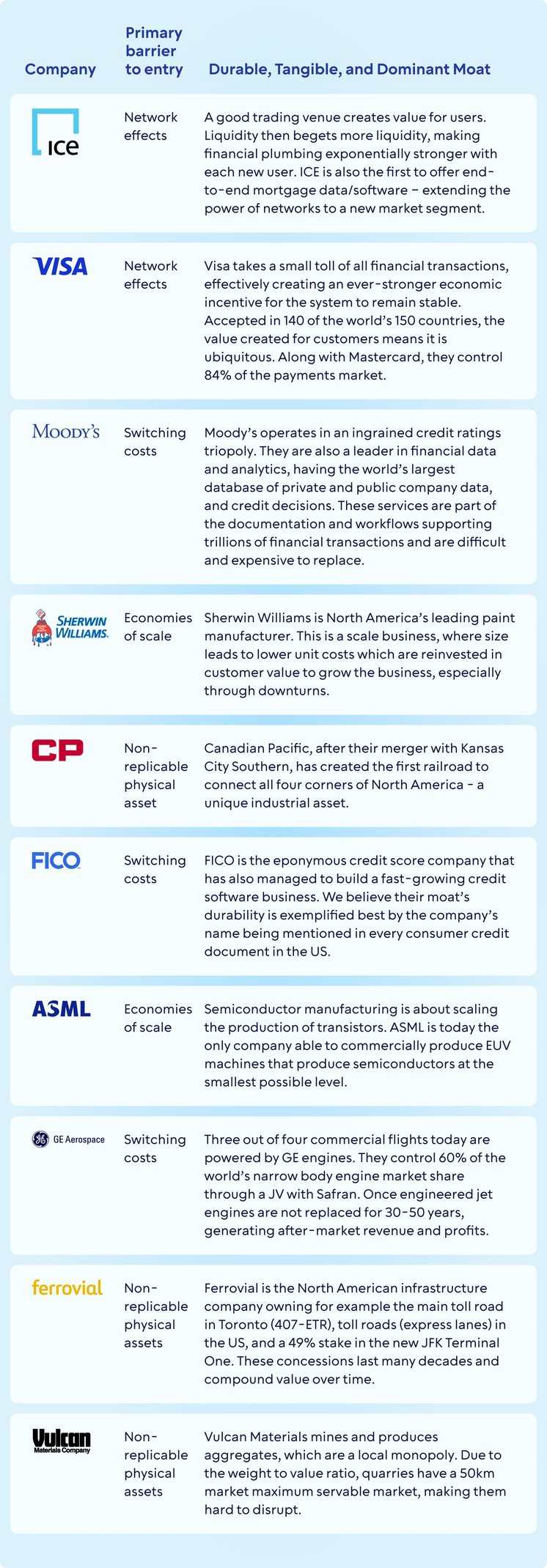
The concept of a moat in business analysis has captured the investing imagination since Warren Buffet first used the analogy. A moat is a barrier to entry around a business protecting it from competition. This concept is simple, intuitive and, by virtue of its double meaning, something even a child could understand. It has Warren Buffet’s stellar compounding returns behind it.
The TOLL ETF aims to utilize and build on this investing approach by focusing on moat stocks that are simultaneously: Durable, Tangible, and Dominant.
Durable Moats
Our stock analysis starts with durability of competitive advantages. The longer a company’s moat can endure, the longer it can generate returns above its cost of capital, driving compounding. Instead of prioritizing wide moats (high returns on invested capital), we focus on more durable moats that we believe can deliver sustained value over time.
Tangible Moats
We focus exclusively on tangible moats, barriers that can be “touched or felt”, i.e., concrete and measurable. Why? Intangible assets, such as brands, have often been viewed as a strong competitive advantage. However, the modern world is one where intangible brand value is under threat. The rise of the internet and social media has dramatically lowered the cost of searching for brands, and the time it takes to build one. New direct-to-consumer brands have proven that they can spring up overnight, powered by Shopify and Instagram ads.
Dominant Moats
Including dominance as a selection factor helps identify firms that have consistently delivered value for customers through mission-critical products and services, and over time won market share. This approach also helps filter out less competitive industries. Without this criterion, moat investors risk being more exposed to industries we believe are prone to disruption such as some forms of technology, consumer, and media.
Some examples of durable, tangible and dominant moat stocks owned in TOLL include:
Holdings are subject to change. For a full and up-to-date list of TOLL holdings, please visit www.temaetfs.com/TOLL.
What do durable, tangible and dominant moats mean for stock returns?
- Moat firms generate on average higher returns on invested capital at 17% over the last 10 years, well above the S&P 500 companies that average 12%1. The market generally assumes these returns will fade under competitive forces.
- We believe dominant, tangible, and durable moats mean these returns are likely to endure and are protected.
- If the latter is true, the equity value may rise as expectations are “beaten”.
- Returns have the potential to compound significantly over time, making durability a critical factor in our view. Every bit of sustained growth counts. To appreciate this, think of the following riddle: A pond with lily pads that double in size each day is fully covered on the 30th day. On which day is it half covered? The answer is the 29th day, highlighting the immense power of compounding and the importance of durability — ensuring investors are still there on the 29th day to reap the benefits of exponential growth.
Conclusion
Buying moat stocks, as championed by Warren Buffett, is a successful form of long-term investing. TOLL aims to build on this approach by looking for durable, tangible and dominant moats. This targets companies with high returns on invested capital that are built to last, offering the potential for sustained long-term outperformance.


 Back
Back


.png)
